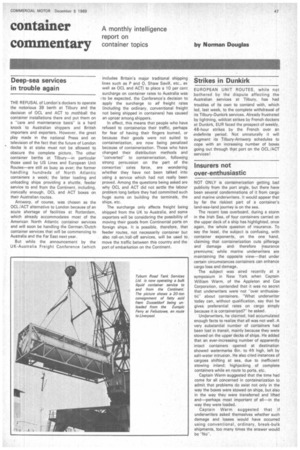container commentary
Page 49

If you've noticed an error in this article please click here to report it so we can fix it.
Deep-sea services in trouble again
THE REFUSAL of London's dockers to operate the notorious 29 berth at Tilbury and the decision of OCL and ACT to mothball the container installations there and put them on a "care and maintenance basis" is a hard knock to Australian shippers and British importers and exporters. However, the great play made in the national Press and on television of the fact that the future of London docks is at stake must not be allowed to obscure the complete picture. The other container berths at Tilbury—in particular those used by US Lines and European Unit Routes—are still as busy as ever; the former handling hundreds of North Atlantic containers a week; the latter loading and unloading ships providing a shuttle, feeder service to and from the Continent, including, ironically enough, OCL and ACT boxes on their Australian routes.
Antwerp, of course, was chosen as the OCL /ACT alternative to London because of an acute shortage of facilities at Rotterdam, which already accommodates most of the American North Atlantic container services and will soon be handling the German/Dutch container services that will be commencing to Australia and the Far East next year.
But while the announcement by the UK-Australia Freight Conference (which includes Britain's major traditonal shipping lines such as P and 0, Shaw Savill, etc., as well as OCL and ACT) to place a 10 per cent surcharge on container rates to Australia was to be expected, the Conference's decision to apply the surcharge to all freight rates (including the ordinary, conventional freight not being shipped in containers) has caused an uproar among shippers.
In effect, this means that people who have refused to containerize their traffic, perhaps for fear of having their fingers burned, or because their goods were not suited to containerization, are now being penalized because of containerization. Those who have changed their distribution methods and "converted" to containerization, following strong persuasion on the part of the consortias' sales force, are wondering whether they have not been talked into using a service which had not really been proved. Among the questions being asked are why OCL and ACT did not settle the labour problem long before they had committed such huge sums on building the terminals, the ships, etc.
The surcharge only affects freight being shipped from the UK to Australia, and some exporters will be considering the possibility of moving their goods from Continental ports on foreign ships. It is possible, therefore, that feeder routes, not necessarily container but also roll-on/roll-off services, will be used to move the traffic between this country and the port of embarkation on the Continent. EUROPEAN UNIT ROUTES, while not bothered by the dispute affecting the Australian services at Tilbury, has had troubles of its own to contend with, which led, last week, to the complete withdrawal of its Tilbury-Dunkirk services. Already frustrated by lightning, wildcat strikes by French dockers at Dunkirk, EUR faced the prospect of weekly, 48-hour strikes by the French over an -indefinite period. Not unnaturally it will augment its Tilbury-Antwerp schedules to cope with an increasing number of boxes going out through that port on the OCL/ACT services!
NOT ONLY is containerization getting bad publicity from the port angle, but there have been several condemnations of it from cargo and marine underwriters. It would appear that by far the riskiest part of a container's land-sea-land journey is on the sea.
The recent loss overboard, during a storm in the Irish Sea, of four containers carried on the upper deck of a ship has highlighted, once again, the whole question of insurance. To say the least, the subject is confusing, with container exponents, on the one hand, claiming that containerization cuts pilferage and damage and. therefore insurance premiums; while marine underwriters are maintaining the opposite view—that under certain circumstances containers can enhance cargo loss and damage.
The subject was aired recently at a symposium in New York when Captain William Warm, of the Appleton and Cox Corporation, contended that it was no secret that underwriters were not "over enthusiastie" about containers. 'What underwriter today can, without qualification, say that he gives, preferential rates on cargo simply because it is containerized?" he asked.
Underwriters, he claimed, had accumulated enough facts to realize that all was not well. A very substantial number of containers had been lost in transit, mainly because they were stowed on the upper decks of ships. He added that an ever-increasing number of apparently intact containers 'opened at destination showed watermarks 6in. to 4ft high, left by salt-water intrusion. He also cited instances of cargoes shifting at sea, due to inefficient stowing inland; highjacking of complete containers while en route to ports, etc.
Captain Warm suggested that the time had come for all concerned in containerization to admit. that problems do exist not only in the way the boxes were stowed on ships, but also in the way they were transferred and lifted and—perhaps most important of all—in the way they were loaded.
Captain Warm suggested that if underwriters asked themselves whether such damage and losses would have occurred using conventional, ordinary, break-bulk shipments, too many times the answer would be "No".






















































































































































